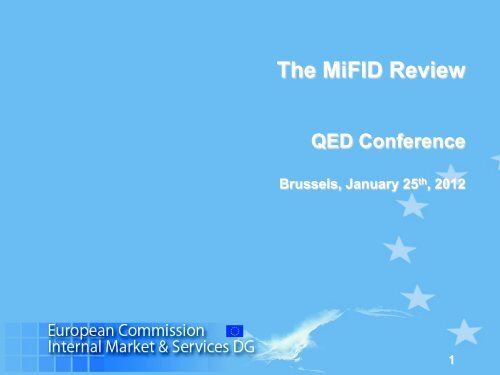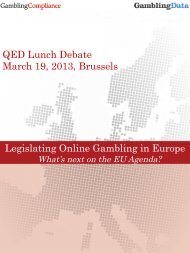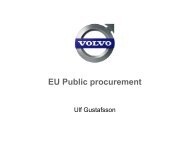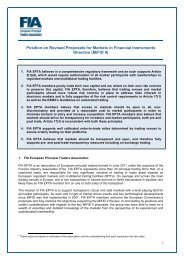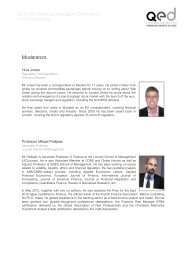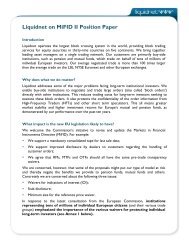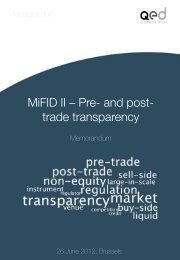Valerie Ledure - Qedcommunication.eu
Valerie Ledure - Qedcommunication.eu
Valerie Ledure - Qedcommunication.eu
You also want an ePaper? Increase the reach of your titles
YUMPU automatically turns print PDFs into web optimized ePapers that Google loves.
The MiFID Review<br />
QED Conference<br />
Brussels, January 25 th , 2012<br />
1
Comprehensive Package<br />
• Markets in Financial Instruments Directive (MiFID II)<br />
• Markets in Financial Instruments Regulation (MiFIR)<br />
• Market Abuse Regulation (MAR)<br />
• Criminal Sanctions on Market Abuse Directive (CSMAD)<br />
• Negotiations on these dossiers have started<br />
• The whole package consisting of MiFID/R and MAR/D<br />
and including all implementing measures on Level 2 is to<br />
become applicable on the same day due to<br />
interdependencies<br />
2
The MiFID review: main objectives<br />
1. Competitive and fair market structures<br />
2. Taking account of technological developments<br />
3. Transparent and resilient trading environment<br />
4. Safe and efficient commodity derivatives<br />
markets<br />
5. High level of investor protection<br />
6. Increased transparency to and powers of<br />
regulators<br />
7. Harmonised third country regime<br />
3
1. Market structure – OTF category<br />
• Introduction of new trading venue (“organised trading<br />
facility – OTF”) to cover hybrid platforms<br />
• Captures all organised trading<br />
• Allows for discretionary matching<br />
• Same organisational, market surveillance and<br />
transparency requirements as for exchanges and MTF’s<br />
• Operator not allowed to trade against proprietary capital<br />
to ensure n<strong>eu</strong>trality<br />
• Conduct of business rules apply to client relationship<br />
• SI is not a trading venue; it is systematic OTC trading<br />
4
1. Market structure – Trading of derivatives<br />
• Mandatory trading of OTC derivatives in line with G20<br />
commitments and in complement to EMIR:<br />
- Scope of derivatives: clearing-eligible and sufficiently liquid<br />
standardised OTC derivatives<br />
- Eligible organised trading venues: regulated markets, MTFs and<br />
Organised Trading Facilities<br />
- Entities covered: All financial entities and non financial entities<br />
subject to the clearing obligation under EMIR<br />
• Trading can occur on third-country venues, provided the<br />
Commission has taken a decision of equivalence and the<br />
regime grants reciprocal recognition for EU trading<br />
venues<br />
5
1. Market structure – Non-discriminatory access<br />
• In complement to EMIR (covers only OTC derivatives)<br />
• To remove commercial barriers in the trading and post-trading space<br />
and ensure effective competition in the exchange-traded derivatives<br />
space:<br />
- trading venues get access to clearing services of central counterparties<br />
on a non-discriminatory basis (incl. regarding collateral requirements<br />
and access fees) in all financial instruments<br />
- central counterparties can offer clearing services in whatever financial<br />
instrument traded on a trading venue on a non-discriminatory basis (i.e.<br />
non-discriminatory access to trade feeds)<br />
- Access to data feeds and licences on a reasonable commercial basis by<br />
any CCP or trading venue (i.e. at a price no higher than the lowest price<br />
at which access has been previously granted)<br />
6
1. Market structure – SME markets<br />
• Creation of a voluntary quality label for SME growth<br />
markets<br />
- Built upon the existing SME junior markets regulated as MTFs<br />
- SME = company with an average market capitalisation of less<br />
than EUR 100 million<br />
- Harmonised listing and transparency requirements<br />
• Strike the right balance between transparency and<br />
investor protection<br />
• Objective is to improve the access of SMEs to capital<br />
markets and facilitate the set up of networks of SME<br />
markets<br />
7
2. Algorithmic trading<br />
• To provide for proper safeguards:<br />
Ø All algorithmic traders, including high frequency, will need a MiFID<br />
license<br />
Ø Reinforce the organisational requirements along the trading value chain<br />
(i.e. both for trading venues and investment firms)<br />
• Reinforcement of the MAD framework:<br />
Ø Clarifying which practices associated with algorithmic/high frequency<br />
trading constitute market manipulation<br />
Ø Connection with MiFID II that establishes new tools for supervisors<br />
intended to facilitate the detection of market abuse (i.e. record keeping<br />
obligation for orders, flagging of orders)<br />
• Algorithmic traders shall keep their trading strategy in continuous<br />
operation and provide liquidity on a regular basis<br />
8


